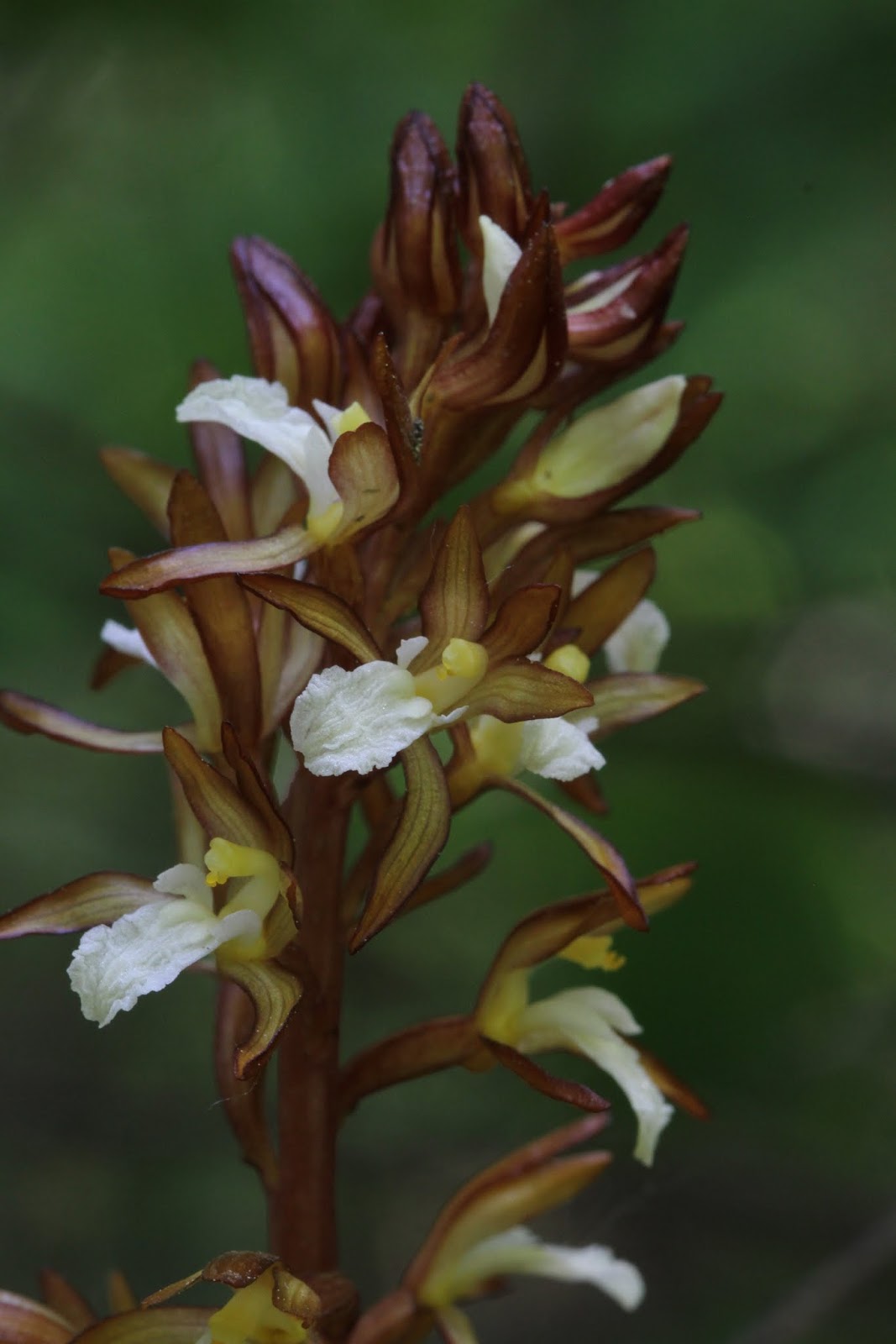This year was a very good season for orchid hunting. In the course of our travels and hiking, myself alone, the two of us together or with others, we not only revisited many sites, but found new sites both in Washington and in the Canadian Rockies. We made a number of excursions with the Washington Native Orchid Society and were able to take them to several locations we had discovered. We also spent three days with friends from Germany who had come to see some of our native orchids and were happy to show them 15 different species and varieties.
The highlight of the year was finding the two Washington native species that we had not seen before. The first of the two was Spiranthes diluvialis, a very rare natural hybrid of Spiranthes romanzoffiana, the Hooded Ladies'-tresses and Spiranthes magnicamporum, the Great Plains Ladies'-tresses. The second was Neottia convallarioides, the Broad-lipped Twayblade, a rather insignificant plant but also rare. Seeing and photographing these two species means that we have seen all of Washington's known native orchids, though not everyone of them in the state of Washington (more on that).
Along with these two we found some interesting new color forms of Corallorhiza maculata, the Spotted Coralroot, a species that seems to be endlessly variable in color. We saw these color forms, both named and unnamed, in both varieties, the ordinary Spotted Corallroot, Corallorhiza maculata var. maculata, and the Western Spotted Coralroot, Corallorhiza maculata var. occidentalis. Seeing so many different forms has convinced us that naming these forms, with a few exceptions, is a useless endeavor not only because there are so many but because the variations are endless.
Other finds were a nearly white form of the Small Round-leaf Orchis, Amerorchis rotundifolia fma. wardii. There is an all-white form which we have not seen, fma. beckettiae, but this form has pale pink makings on the lip. There are numerous color forms of this species and several others as well that we have yet to see, but were very pleased to find a few of these growing among many other normally colored forms. In fact, we have found that having seen all of our native species many times, we spend more time looking for unusual examples and rare color forms.
That leaves us with plans for 2015, which we intend to be much more relaxed. I have in mind seeing in the state the Washington native species that I have not seen there, though I have seen them elsewhere. They are Coeloglossum viride var. virescens, the Long-bracted Green Orchis, Listera borealis, the Northern Twayblade, Liparis loeselii, the Fen Orchis, Platanthera obtusata, the Blunt-leafed Rein Orchis, and Platanthera orbiculata, the Pad-leaved Orchis. We've seen these elsewhere but would like to see them here, though some of them are very rare in the state.
We would also like to see the species we did not see this season and would especially like to visit northern California and southern Oregon once again. Along with seeing these we would like to see in Alberta, in California and in some of the states bordering the Pacific Northwest, some of the new species we have not seen before. There are also a number of Pacific Northwest species that are found only in Canada and Alaska that we would like to see, but all these plans depend on time and opportunity. In any case we intend to continue our orchid hunting.
%2B%2312.JPG)
%2B%23124.JPG)
%2B%232.JPG)
%2B%2314.JPG)
%2B%2318.JPG)
%2B%2322.JPG)
%2B%2318.JPG)



%2B%2320.JPG)
%2B%234.JPG)
%2B%2319.JPG)


%2B%2339.JPG)

10 comments:
I love your coralroot photos.... I need to look for more varieties next year!
Thanks for the visit, Rich. As I've said before, I'd be happy to help. Just let me know when and what.
Hi Ron!
Thanks for showing us these marvelous and precious native orchids. Here, in Europe I am always searching and taking photos of our native orchids. This is an absorbing and extraordinary activity.
Thanks, friend, for taking the time to look and comment. If you are ever in the Pacific Northwest I would be delighted to take you around to see some of our orchids.
I'd like to give a wide walk through those places to see these beautiful native orchids. Congratulations on finding these fantastic and rare species, Ron. Hugs
If you are ever in the Pacific Northwest we would be delighted to take you to see some of these orchids, Angel. We took a couple from Germany around this past summer and were able to see 15 species.
Not only are the plants very beautiful, but also the landscape and their habitats. Not to forget, that Ron is a are a very good guide and that he and his wife were wonderful hosts. One day I would love to return.
Ron, those are great pictures. Especially the pictures of the variants of coralroots, which seem so typical for your forests.
Thanks for the kind words, Martin. It was a delight to take you around and I sincerely hope you are able to come again some day.
Hi Ron, love your photos. They are eye-candy as always. I have been remembering your photos as of late and came here looking for them. Great finds! I still have to find the right year to get up to your neck of the woods and find some orchids to photograph. Thanks for posting.
Thanks, friend. If you get out this way I'd be delighted to show you around.
Post a Comment